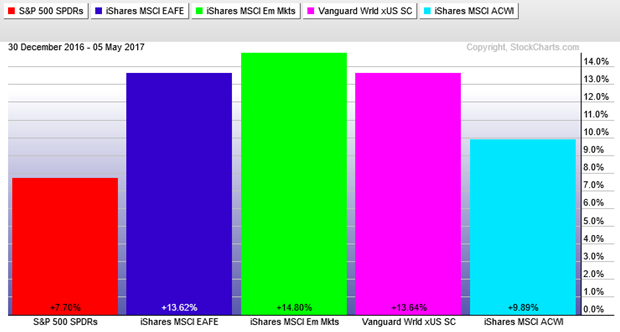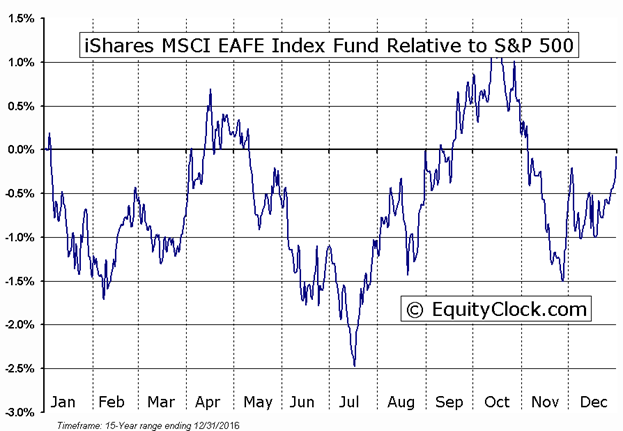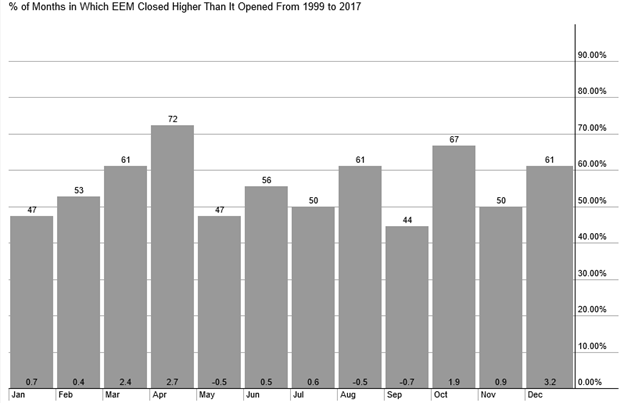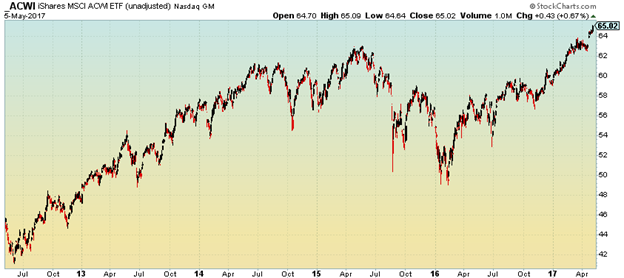International stocks have been making multi-year highs as the S&P 500 remains below its March 1 peak, this despite an all-time daily closing high last Friday.
I like to keep an eye on a few key ETFs that track international stock market performances: International Developed Markets (NYSEARCA:EFA), Emerging Markets (NYSEARCA:EEM), Iinternational Small Caps (VSS) and The World of Stocks (NASDAQ:ACWI).
Each of these broad ETFs has generally lagged US markets in recent years, despite occasional short periods of outperformance. Year-to-date, however, the S&P 500 is the clear laggard.
Here’s a visual:
EFA’s strong start to the year may be the most remarkable of the aforementioned international ETFs. Among SPY, EFA and EEM, EFA has never been the top performer in a given year dating back to 2002; it tends to be a less extreme version of the emerging markets ETF, EEM. To start 2017, however, it is very close to matching the strong start of EEM. Much has been made of the strong performance of the UK’s FTSE 100, German DAX, and France’s CAC 40; these indexes have a significant weighting in EFA. One cautionary indicator is the seasonality of EFA versus the S&P 500 – EFA tends to underperform SPY from early May through mid-July, according to data from EquityClock.com.
EEM’s strong start is not atypical. The below chart shows its monthly performance and percent-positive statistic since 1999. May through September has been a tough stretch for the emerging market fund, with an average total return of -0.6% from May 1 through September 30 since 1999. In contrast, the average total return starting October 1 until April 30 is 12.8%. The old “sell in May and go away” mantra perhaps is more applicable to EEM than SPY.
VSS is a lesser-known ETF. It consists of international small caps, which I believe are an important group of stocks to hold in a long-term account for diversification and growth benefits. The portfolio consists of a mix of developed and emerging market small caps, so an investor should expect significant volatility. Year-to-date however, it has been a steady incline with few distribution days. The below chart has a popular technical indicator imposed, Bollinger Bands. Notice the squeeze of the bands in April, and subsequent breakout in price. This breakout to new 22-month highs appears to bode well for higher prices in the coming months.
Finally, ACWI is another less well known ETF. It is inclusive of US and non-US stocks, so I refer to it as ‘the world of stocks’, however it is market cap-weighted, so it will not represent smaller companies very heavily. Another rule of the thumb for ACWI’s portfolio is that it consists of roughly half SPY, half EFA. Again this is not exact as there is certainly some emerging market exposure in the ETF, but the historical correlation and performance of ACWI to a portfolio of 50% US large cap and 50% non-US developed market stocks is very high and close, respectively. ACWI has finally broken out above its 2015 highs after consolidating in March and April.
The US small cap surge following the US elections in 2016 quickly lost steam and gave way to international outperformance. Perhaps this trend will persist with many market participants and pundits believing the “America first” political tagline – as the famous (and infamous) trader Jesse Livermore aptly put it, the stock market is “designed to fool most of the people, most of the time.”
Thanks for reading.
Twitter: @MikeZaccardi
Any opinions expressed herein are solely those of the author, and do not in any way represent the views or opinions of any other person or entity.













